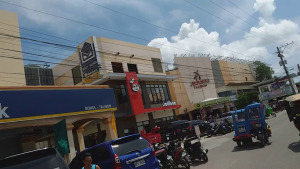Proem
When the Spaniard Miguel Lopez de Legazpi was in Hinawanan, Loay, Bohol he performed two Blood Compacts on board the flagship San Pedro. The first was with the native chief Sikatuna on March 25, 1565 and the second was with chief Sigala on March 28, 1565.
If you have a colonial mentality the tendency will be to emphasize the Sikatuna-Legazpi Blood Compact. If you have a nationalist mentality the tendency will be to favor the Sigala-Legazpi Blood Compact.
Sikatuna-Legazpi Blood Compact
On 25 March 1565, Chief Sikatuna boarded the flagship San Pedro with four native companions. The records stated that the following natives executed affidavits before the Notary of the Fleet Hernando Riquel. The names are: a.) Magut – a Bornean Moro who have been living in Bohol for some time already. b.) Sibumanglar – a native Boholano. c.) Ximongoi – a native Boholano. d.) Ceilan – a Bornean Moro who have been living in Bohol for some time already.
If we want the names of the companions of Sikatuna, then we can assume that Magut, Sibumanglar, Ximongoi, and Ceilan were the companions of Sikatuna. Why would they be in the flagship to execute affidavits?
So we can revise the diorama of the scene of the Sikatuna-Legazpi Blood Compact. In the Boholano side will be Sikatuna, Magut, Sibumanglar, Ximongoi, and Ceilan. In the Spanish side will be Gen. Legazpi, Capt. Juan dela Isla, Capt. De Goite, and Capt. Sanz. The interpreters were Fr. Andres de Urdaneta and Tuasanmalea, the Pilot of the Bornean Parao that was captured by the Spaniards. In other words the scene will have a “balance of powerâ€.
The Ceremony
Here is my English translation of the Blood Compact ceremony written in Document 27, page 297 of the Coleccion De Documentos De Ultra Mar: “Sikatuna arrived at the flagship. The General received him graciously with motions of friendship. The Chief said, I want a blood compact with the General. Because we would celebrate a true friendship, we would do the following; extract from each breast two drops of blood. Mix it with wine in a silver cup, after that divide it into two cups equally. After that, each would drink his share of the mixture of blood and wine. After it was done, the Chief motioned that he was satisfied.â€
It is very clear from the record that the blood was taken from the breast and not from the arm. Therefore Gen. Legazpi was not wearing armor. And why would Legazpi be wearing armor when he was not preparing for battle?
Sigala-Legazpi Blood Compact
On March 28, 1565 Chief Sigala and companions came to the flagship. The record states the following, “One day while we were at the Port, there came to the flagship a native Chief…that person motioned that he was a higher Chief and of better quality than Sikatuna. That Chief was named Sigala.â€
A Blood Compact was performed similar to the previous one. After the ceremony the Chief gave a piglet (lechon) as a present. Then he brought out a cantaro (about 4 gallons) of palm wine (Bis: tubâ) and invited the General to drink.
Comparison
The Sikatuna-Legazpi Blood Compact was in the context of the Spaniards. The wine, the cups, and other peripherals used were Spanish.
The Sigala-Legazpi Blood Compact was in the context of the Boholanos. The wine was the native tubâ (toddy). You will not drink tubâ in a Spanish cup but with the use of the húngot (coconut shell cup). The food eaten was the lechon.
Therefore, if you favor the Sikatuna-Legazpi Blood Compact, it is clear that you have a colonial mentality. However, if you have a nationalist mentality you should favor the Sigala-Legazpi Blood Compact.
Spanish Propaganda
In the year 1596 or 31 years later, two Spanish Jesuit Priests arrived in Baclayon, Bohol. They were Fathers Juan de Torres and Gabriel Sanchez. Fr. Sanchez, who was younger and more active, found in the hinterland of Baclayon the old Chief Sikatuna and his wife Albasea.
Upon learning that the old man was the person who made a Blood Compact with General Legazpi, Fr. Sanchez endeavored to convert him to Christianity. Fortunately or unfortunately, Sikatuna converted and he was baptized. Sikatuna was given the Christian name “Joaquin†and his wife was named “Anaâ€. The new Christianized chieftain helped in the construction of the church at Baclayon. (Note: San Joaquin and Santa Ana, the parents of Mother Mary, are placed prominently at the altar of Baclayon Church.)
The conversion of Sikatuna to Christianity was reported by Fr. Sanchez to his superiors. The Spaniards were very happy. The conversion became propaganda material for the Spaniards and repeated again and again in many Spanish records.
After the lapse of time only the Sikatuna-Legazpi Blood Compact was remembered and given prominence. Sigala, even though he was a “higher chief and of better quality†was forgotten because he did not convert to Christianity. Sigala stayed true to his native religion, which was similar in belief system to the Jewish Cabbala.
Now we are told the legend that Sikatuna was the Chieftain of Bohol when he performed the Blood Compact. The real fact is, Sikatuna was only a minor chieftain.
The leaders of the Bo-ol Kingdom when it was destroyed were Princes Manangkil Way Tupóng or known in history books as Pagbuà ya and Way Lisang Makabungkág or Dailίsan. Sikatuna was only a minor chief living at the shoreline of Guiwanon, Baclayon. (Note: Historian Gregorio Zaide called it “Baclayonâ€.) Sikatuna was wounded during the invasion of the Portuguese and Ternateans and brought to Himilian (tubod), Loboc by Sigala.
Comment
It took me 18 years of consistent writing until the National Historical Institute declared that the actual site of the Sikatuna/Sigala-Legazpi Blood Compacts was Hinawanan, Loay and not Bo-ol, Tagbilaran. I don’t know the above facts will be the stock knowledge of every Boholano.





Be First to Comment